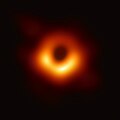| Distance | System | Component | Notes and additional references |
|---|
| (ly) | (kpc) | Designation | Description | Right ascension [4]
(Epoch J2000.0) | Declination [4]
(Epoch J2000.0) | Discovery
date [5] | Designation | Stellar
class | Mass
(M☉) |
|---|
| 1,560±10 | 0.478±0.005 | Gaia BH1 (TIC 125470397) | Binary system with orbit t=185.63 d and eccentricity e=0.45 [3] | 17h 28m 41.09s | −00° 34′ 51.93″ | 2022 | A | BH | 9.78 | [3] |
| B | G | 0.93 |
| 1,840±30 | 0.5906±0.0058 | Gaia BH3 (Gaia DR3 4318465066420528000) | Binary system with orbit t=11.6 yr and eccentricity e=0.7291 | 19h 39m 18.72s | +14° 55′ 54.2″ | 2024 | A | BH | 32.70±0.82 | [6] |
| B | G | 0.76±0.05 |
| 3,800±80 | 1.16±0.02 | Gaia BH2 (Gaia DR3 5870569352746779008) | Binary system with orbit t=1276.7 d and eccentricity e=0.518 | 13h 50m 16.728s | −59° 14′ 20.42″ | 2023 | A | BH | 8.93 | [7] [8] |
| B | K III | 1.07 |
3,800+2,700
−2,000 | 1.18+0.82
−0.63 | Gaia18ajz | Candidate for isolated black hole detected by microlensing [9] | 18h 30m 14.460s | −08° 13′ 12.756″ | 2024 | | BH | 12.0+14.9
−5.4 | Most probable solution parameters shown. Another solution has a mass of 5.6 MSol. |
| 4,700±800 | 1.44±0.25 | A0620-00 (V616 Mon) | Binary star system with orbit t=7.75 h | 06h 22m 44.503s [10] | −00° 20′ 44.72″ [10] | 1986 | A | BH | 11.0±1.9 | Low-mass X-ray binary |
| B | K [11] | 0.5±0.3 | |
| 5,150±590 | 1.58±0.18 | MOA-2011-BLG-191 or OGLE-2011-BLG-0462 | Isolated black hole detected by microlensing [2] | 17h 51m 40.2082s | −29° 53′ 26.50″ | 2022 | | BH | 7.1±1.3 | First confirmed black hole detected via microlensing |
5,400+6,900
−1,900 | 1.7±1.4 | GRS 1124-683 (GU Muscae) | Binary star system with orbit t=10.38 h | 11h 26m 26.60s | −68° 40′ 32.3″ | 1991 Jan 20 | A | BH | 6.95±1.1 | |
| B | K | 0.9±0.3 | |
| 5,720±300 | 1.7±0.1 | XTE J1118+480 | | 11h 18m 11s | 48° 02′ 13″ | 2000 | A | BH | 6–6.5 | |
| B | M | 0.2 | |
| 7,300±200 | 2.25±0.08 | Cygnus X-1 (Cyg X-1) | Binary star system with orbit t=5.6 d | 19h 58m 21.676s [12] | +35° 12′ 05.78″ [12] | 1971 April–May | Cyg X-1 | BH | 15±1 | The first X-ray source widely accepted to be a black hole. |
| HDE 226868 | O [13] | 30±10 | |
| 7,800±460 | 2.39±0.14 | V404 Cygni | Binary star system with orbit t=6.5 d | 20h 24m 03.83s [14] | +33° 52′ 02.2″ [14] | 1989 May 22 | A | BH | 9 | First black hole to have an accurate parallax measurement of its distance from the Solar System |
| B | K [4] | 0.7 | Early K giant star |
| 8,100±1,000 | 2.49±0.30 | GRO J0422+32 | Binary star system with orbit t=5.09 h | 04h 21m 42.723s | +32° 54′ 26.94″ | 1992 Aug 5 | A | BH | 3.97±0.95 | |
| B | M1 | 0.5±0.1 | |
| 8,150 | 2.5 | MACHO-96-BLG-5 | Candidate isolated black hole detected by microlensing [15] | 18h 05m 2.50s | −27° 42′ 17″ | 2001 | | BH | 5.30+1.14
−0.96 | Very strong candidate, parameters listed are of best fit |
| 8,800±2,300 | 2.7±0.7 | GS 2000+25 | | 20h 02m 50s | +25° 14′ 11″ | 1988 | A | BH | 7.5 | |
| B | M | 0.5 | |
9,260+6,330
−5,450 | 2.84+1.94
−1.67 | Gaia18cbf | Candidate isolated mass-gap black hole detected by microlensing [16] | 16h 04m 38.862s | −41° 06′ 17.32″ | 2022 | | BH | 2.65+5.09
−1.48 | Best fit. Second-best fit has a mass of 1.71 MSol, which would make it a neutron star. |
| 11,000±980 | 3.4±0.3 | Swift J1727.8-1613 | Detected via a transient X-ray event [17] | 17h 27m 46.0s [17] | −16° 12′ 5.3″ [17] | 2023 | A | BH | 3.12±0.10 | [18] |
| B | K4V | <0.78 | [18] |
| 11,100±700 | 3.4±0.2 | Cygnus X-3 | Binary star system with orbit t=4.8 h | 20h 32m 25.766s | +40° 57′ 28.26″ | 1967 | Cyg X-3 | BH | 2.4+2.1
−1.1
[19] | |
| V1521 Cyg | WN | 10.3+3.9
−2.8
[19] | |
| 11,400 | 3.5 | MACHO-98-BLG-6 | Candidate isolated mass-gap black hole detected by microlensing [15] | 17h 57m 32.80s | −28° 42′ 45″ | 2001 | | BH | 3.17+0.52
−0.48 | Very strong candidate, parameters listed are of best fit |
| 11,900±3,600 | 3.7±1.1 | GRO J1655-40 | Binary star system with orbit t = 2.6 d | 16h 54m 00.137s | −39° 50′ 44.90″ | 1994 | A | BH | 5.31±0.07 | |
| V1033 Sco | F5IV | 1.9±0.3 | |
| 15,700 | 4.8 | MACHO-99-BLG-22 | Candidate isolated black hole detected by microlensing [20] | 18h 05m 05.28s | −28° 34′ 41.70″ | 2002 | | BH | 7.5 | Very strong candidate |
| 25,600±600 | 7.86±0.2 | Sagittarius A* | Supermassive black hole | 17h 45m 40.0409s | −29° 0′ 28.118″ | 1974 | | BH | 4,154,000 ± 14,000 | Center of the Galaxy |
| 29,700±2,700 | 9.1±0.8 | 4U 1543-475 | Binary star system with orbit t = 26.8 h | 15h 47m 08.277s | −47° 40′ 10.28″ | 1971 | A | BH | 9.4±2.0 | |
| B | A2V | 2.7±1.0 | |
|
